The 36th District's Sen. Jeanne Kohl-Welles may feel like a legislator's job is never done. A long-time supporter of medical marijuana, she watched last April as Governor Gregoire signed Senate Bill 5798 into law, which widened the scope of medical professionals who could legally prescribe medical marijuana for patients suffering from debilitating and terminal illnesses.
But she also read, no doubt, the headlines about the raids on patients' homes and dispensaries, as agreement on medical marijuana's legality is not shared with the same force or fervor statewide. Since 1998, people have been regularly arrested for taking I-692 at its word. This year, joining with Rep. Jim Moeller, she's introduced new legislation that tries to make crystal clear Washington’s existing medical marijuana laws.
"Senate Bill 5073 and House Bill 1100 would establish a regulatory system for the sale and purchase of medical marijuana for qualifying patients," says Kohl. It contains a sales tax exemption for patients, but dispensaries would have to pay a B&O tax.
Law enforcement would have to consult a voluntary registry of patients before kicking doors down on suspicion of marijuana use. The legislation defines "licensed dispenser" (regulated by the Department of Health), "licensed processor" (Department of Agriculture), and "licensed producer" (Department of Agriculture), and specifically protects them from being hauled into court due to their licensed activities.
"Other provisions include protecting parental rights of medical marijuana patients and protections against the workplace discrimination of patients," adds Kohl-Welles. "The current legal limits of up to 15 plants and up to 24 ounces of useable marijuana per patient and one patient per provider remain intact."...
Unfortunately I can't envision the scenario where the downtrodden artists and federal functionaries team up to stop the deep-bore tunnel; but on the other hand, the artists may appreciate the chance to sit back and let the Feds do the heavy lifting.
At a "Guess the Dow" lunch at the Met last week (I'm holding off on writing that up until I can get all my stock picks locked in), I heard an interesting expression used to describe the pro-tunnel strategy: an "assumptive close." Maybe that's why a general lack of interest has greeted the news that the tunnel will mean the demolition of the 619 Western building.
Artists colony aside, Seattle has fought harder for historic buildings than this. Nor is 619 Western the only building threatened--as Cary Moon has said elsewhere, the project's DEIS mentions "possible damage to 12 historic structures (Ch 2 pg 31), and possible collapse or dramatic damage to two buildings (Ch 6 pg 142) because of difficulty controlling soil loss or preventing over-excavations or sinkholes."
Contrast this tone with the more peremptory federal General Services Administration letter sent to WSDOT in November, uncovered by Erica Barnett at PubliCola:
...Graf noted that the GSA has not given WSDOT the right to drill its tunnel under the building, and that "consequently, we will not be granting any further access to the federal property by the project team, their contractors, or potential bidders."
By December, the GSA was noting that the tunnel would either run just below their building's piered foundation or through it, placing "this historic building and its occupants in permanent jeopardy." "The Federal Office Building is an exuberant example of Art Deco architecture." (It may be a wonderful tunnel, but absolutely no one seems happy to have it beneath them. Earlier, the Gates Foundation threw the tunnel plan a curve.)...
At 10:30 a.m., you can watch a policy briefing at the White House here, featuring Shaun Donovan, secretary of the U.S. Department of Housing and Urban Development; Milwaukee Mayor Tom Barrett; Oakland Mayor Jean Quan; Providence Mayor Angel Tavera; Angela Blackwell, founder and CEO of PolicyLink, and our own Seattle Mayor Michael "Mike" McGinn.
They'll be holed up in the Eisenhower Executive Office Building talking about the greening of American cities. After the briefing there's a panel on "Scaling Up the Energy Efficiency Industry: Stimulus and Beyond," which lasts until 2 p.m. PST.
Ten U. S. cities are part of this launch of the Emerald Cities Collaborative--Seattle, along with Portland, Oakland, San Francisco, Los Angeles, Milwaukee, Atlanta, New York, Cleveland, and Providence, RI. Soon we'll be knee-deep in collaboration on city-based strategies for gains in carbon reduction and energy efficiency, in addition to the cultivation of "high-quality and equitable job opportunities and involvement of low-income communities of color."
For a while we've been asking if this will be the year when a final decision is made on the fate of the Viaduct.
Last year Olympia spoke, and it looks we get a tunnel.... [Sound of slide whistle]. In fact, today WSDOT and the Seattle Tunnel Partners are signing on the dotted line.
With the project in its infancy, there is still time for politics to get in the way. However, something better happen fast, because once the boring machine starts ripping up the Valley of the Mole People this summer, well, you gotta think there will be little turning back.
So this time around, we are asking this question:
Weigh your options carefully. Unlike the Viaduct, you only get one chance at this.
I'm pleased to report that metaphysical poets are not the only people able to yoke together two opposed ideas, and argue them with conviction.
Eight months ago, Governor Gregoire appointed a number of business leaders to a task force and asked them how to increase in the number of students graduating from Washington's four-year colleges and universities. Now, the Seattle Times sums up their findings: "State task force says colleges, not Legislature, should set tuition."
The problem is that, while constant reductions in state funding are starving university growth, the state has retained the power to tell state colleges and universities how to much charge for tuition. School leadership has chafed under this arrangement, but last year's bill to allow tuition-setting to revert to the state schools failed to move out of committee.
While you can debate the "right" of higher education leadership to sail their own ships, there's something fishy about the notion that if only tuition were raised, all would be well. (The task force "laid out the groundwork Monday for a 27 percent increase in the number of students who graduate from the state's four-year colleges and universities by 2018.") As I've mentioned before, while the state holds the tuition pursestrings, it's done so fairly loosely: in 1991, UW tuition was $2,178. Last year, it was $7,125.
(Permit me the slightly ad hominem observation that if task force leader Brad Smith, senior vice president and general counsel at Microsoft, has great ideas that grow institutions by 27 percent over the next eight years, he should put them to work at Microsoft first. Shareholders would thank him.)...
It's that time of year; the weather is wintry, night comes early.
And although I pride myself on tootling around town year-round on my bike, I start leaving it at home because the streets have all grown potholes of sizes that make riding dangerous.
At night, they're hard to spot, full of rainwater, and I'm usually busy watching out for cars that don't see me, so there's just that unpleasant second as the front wheel drops and then a wrist-breaking impact that sends me half over the handlebars.
I see car drivers grimace, too, as their rims transmit the shock. Some of these potholes feel like they're going to take your axle with them. Seattle neighborhoods have come to feel like proving grounds for SUV manufacturers.
On the one hand, potholes are a fact of Seattle's brand of winter weather: studded tires, chains, and snow plows damage the road surface, and heavy rains invade any cracks and crevices to lift asphalt away from the road's subsurface, so that chunks eventually just pop free. (All year, heavy bus and truck traffic creates ridges and ruts in roads not rated to carry them.)
To deal with this fact of life, the city has deputized Pothole Rangers to tackle quick fixes; you can report potholes online (or call 684-ROAD) and they should be filled within three business days.
But on the other hand, the sheer number of potholes are also a fact of budget. (To deal with the Seattle Department of Transportation's deficit of almost $8 million, one 5-person crew was eliminated, and an extra day was added to the expected wait, from 48 to 72 hours. We're told the new patches will last longer, and I certainly believe that SDOT will act as if they are lasting 12 months.) Besides the backlog dealing with hundreds of new potholes, SDOT has a chronic backlog of failing streets it needs to fix. ...
As we've mentioned before, Washington state is facing substantial declines in gas tax revenues; "State Transportation Revenue Craters" is how Sightline's Eric de Place put it more recently, noting the long-range revenue forecast had dropped by $1.7 billion in the latest revision. So get ready for more road tolls, vehicle excise taxes, local taxes, and even a tax on alternative-fuel vehicles, as the state attempts to claw the missing amount from your wallet.
It's not clear how much of the gas tax drop is due to people driving less and how much is due to greater fuel efficiency, but it is clear that it's national in scope. The Washington Transportation Commission, who should know, puts fuel efficiency first and driving less last, without breaking out proportions of impact: "At the same time, we can see fuel tax revenue--the primary source of transportation revenue in our state--declining as the vehicles we use become more fuel efficient, people find new ways of traveling, and some choose to drive less."
De Place says breaking out those exact proportions is on his to-do list, but that both fuel efficiency and vehicle miles traveled can be fairly said to be significant factors in reduced gas tax revenues. "Projecting into the future," he writes in an email, "fuel efficiency is much more of a 'given' for analysts of all stripes (since federal standards are on the books already). And then a subset of analysts are bearish about the prospects of driving in general (for a whole variety of reasons, including demographics, expense, employment patterns, cultural changes, etc)."
If you include both state and federal gas tax monies, the WTC points out, "it is noteworthy that approximately 64 percent of current transportation funding is dependent on how much fuel cars and trucks consume." So if we go on consuming less gas...well, it's too horrible to contemplate.
(In point of fact, it is problematic to depend so heavily on a single point of funding; the corollary is public transportation and the decline in sales tax revenues. However, because Washington state's 18th Amendment requires gas tax revenues to be spent only on roadways, gas taxes have heretofore been a bulwark for the pro-highway lobby, who never had to worry about desperate times cutting into their piece of the tax pie. Not coincidentally then, Washington ranks seventh out of 50 states in total gas taxes.)
Like it or not, the WTC argues, the bulk of Washington's major roadways were built from the 1950s to the '70s, and are now worn out. (Check out our state's bridge ratings.) With "limited resources, the focus should be on preservation and maintenance, with a lower priority placed on building new facilities," says the WTC, though Seattle's two megaprojects--the SR 99 tunnel and the 520 bridge replacement--are both smaller and larger, respectively, than existing structures. The tunnel doesn't preserve capacity, and the replacement bridge would significantly expand it (at least until the choke points at either end)....
Over in the Other Washington, a historic "lame duck" session is over. The propaganda machine's weekly West Wing video features several signings, including DADT repeal and the compromise (or compromised) tax bill, and the receipt of the 2010 U.S. Census from Commerce Secretary--and former Washington State Governor--Gary Locke.
(I kind of <3 Secretary Locke. We used to see him--and sometimes Ms. Mona--in the Capitol Hill QFC on a fairly regular basis, and he was always thoughtful and courteous.)
The holiday week closes the 111th Congress of the United States, which is being widely acclaimed for getting tons of shit done, not all of it as glamorous as the repeal of Don't Ask, Don't Tell. Whether one agrees with the various legislation is a matter of personal conviction, but here's a partial list of what all got signed in just the last week:
Don't Ask, Don't Tell Repeal Act of 2010; Airport and Airway Extension Act of 2010 Part IV; Coast Guard Authorization; Kingman and Heritage Islands Act of 2010; Bankruptcy Technical Corrections Act of 2010; Ray Daves Airport Traffic Control Tower, Spokane, Washington; Regulated Investment Company Modernization Act of 2010; Reauthorization and Enhancement of Johanna's Law; Hoh Indian Tribe Safe Homelands Act; Preserving Foreign Criminal Assets for Forfeiture Act of 2010; Arlington National Cemetery Management Reports; Early Hearing Detection and Intervention Act of 2010; Truth in Caller ID Act of 2009; Private Relief for Shigeru Yamada; Private Relief for Hotaru Nakama Ferschke; Longfellow House-Washington's Headquarters National Historic Site Designation Act; Museum and Library Services Act of 2010; FOR VETS Act of 2010; Leases Involving Certain Indian Tribes; Longline Catcher Processor Subsector Single Fishery Cooperative Act; Leases of Restricted Land; National Foundation on Fitness, Sports, and Nutrition Establishment Act; Criminal History Background Checks Pilot Extension Act of 2010; CAPTA Reauthorization Act of 2010; Continuing Appropriations, FY 2011 (Continuing Resolution thru Dec 21); Red Flag Program Clarification Act of 2010; Social Security Number Protection Act of 2010; Administrative Operations of the Office of the Architect of the Capitol; H.R. 6184 - Water Resources Development Act of 2000 Amendment; H.R. 3237 - National Aeronautics and Space Act; Truth in Fur Labeling Act of 2010; Tax Relief, Unemployment Insurance Reauthorization, and Job Creation Act of 2010....
This morning, President Barack Obama signed the repeal of Don't Ask, Don't Tell, the 1993 bill that was designed to allow gay and lesbian Americans to serve freely, though not openly, in the U.S. military. There has been a lot of noise about DADT: it was unjust, discriminatory, dishonest, et cetera. That is all true. It was a bad bill, whose main purpose was to send a message to the military to stop killing gay people.
That goal was more or less accomplished. And, in an unexpected, backhanded way, DADT changed the nature of the debate about gays and lesbians in the armed forces. The conversation stopped (for the most part) being about stupid shower jokes as 12,000 to 15,000 Americans were discharged, one after another, for being the best and the brightest our country has to offer--like Air Force Major Margaret Witt and National Guard Retired Colonel Margaret "Grethe" Cammermeyer of Washington state, both of whom were on hand to witness today's signing.
The repeal of DADT will not take place immediately. The Pentagon has an 87-page implementation plan, and once that is reviewed, President Obama, Defense Secretary Robert Gates, and Navy Admiral Mike Mullen, chairman of the Joint Chiefs of Staff, each will have to certify that the repeal can proceed without harming unit cohesion and military readiness. After the certification, another 60 days will need to pass before the repeal is officially enacted....
"I hate my budget," was the literal money quote from Governor Gregoire, who went on to add, "in some places, I don't even think it's moral."
For the non-budget wonks among us, it's hard to square cutting $4.6 billion out of the 2011-13 two-year budget, so that it still totals a staggering $32.4 billion, with the scorched earth that's being reported: per the Seattle Times, say goodbye to the State Arts Commission and Tourism Office, the Basic Health Plan (an additional 66,000 without health insurance), the Disability Lifeline, state parks funding, and programs for gifted children and juvenile offenders. Here's an itemized list.
(Last Friday, the governor went on to suggest $1.1 billion in cuts from this biennial budget, starting early axe-work on the Basic Health Plan and Disability Lifeline, plus the Children's Health Program, state food stamp assistance, and education funding that supports poorer schools and smaller class sizes.)
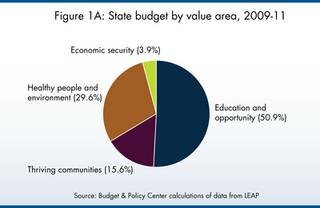 Washington Budget & Policy Center
Washington Budget & Policy Center
So what are we spending $32.4 billion on, exactly? That's the question I asked the Washington State Budget & Policy Center's Remy Trupin the day the state announced a $5.7 billion deficit. You might be surprised to learn that the state's prime directive, as it were, is to fund education. Over half of the state's budget goes to schools ($13.6 billion in 2007-09), higher education ($2.2 billion), and job training ($1.4 billion).
Because education is the state's top priority, that means that health and social services, environmental protection, and things like worker childcare assistance get cut first. But what sounds like a "reasonable" downsizing of the total budget, say six percent, is actually being repeatedly carved out of a much more limited area. Depending on how you slice it, you could be talking about cuts of 25 to 30 percent from budget sectors, and that's when whole programs suddenly go missing....
 Of course, the problem could also be the model Pacific Place shopper (pictured) won't fit beneath the low ceilings of a parking garage.
Of course, the problem could also be the model Pacific Place shopper (pictured) won't fit beneath the low ceilings of a parking garage.
I've been using Occam's Razor a lot lately--if I could, I'd shave with it and save a ton of money--so I wonder if a consultant is needed. The thing is, the parking garage worked like a charm for the first eight to ten years of its existence. Even though it was priced below market rate, at $2 per hour, it made up enough in volume (it parks 1,200) to pay for its debt and operations.
It's just that more recently, between 2004 and 2009, use has fallen almost 18 percent, says the Times' Emily Heffter. In 2008, it failed to make enough money to pay for itself. (By city ordinance, it's forbidden to make a profit or build up substantial cash reserves.) In tandem with use falling, the parking rate there has increased to $5 per hour.
It's as if, in a microeconomic sense, there's some indefinable but real-world relationship between the cost of parking and the number of people willing to park there--while at the same time, there's the macroeconomic effect of a major economic downturn having taken place.
To rejigger an old expression, "If it wasn't broke before, undo whatever you did to fix it." In this case, that would seem to indicate rolling back prices. (This doesn't mean you should lower on-street metered parking rates; they are being used so much they're never open, which indicates that most people find them a good deal, comparatively.)...
 Seattle-based Women’s Funding Alliance (WFA), the leading foundation in Washington state investing in and advocating for women and girls, is confronting the issue of local sex trafficking from numerous angles with the aim of attacking the root cause of the problem through education, awareness and funding.
Seattle-based Women’s Funding Alliance (WFA), the leading foundation in Washington state investing in and advocating for women and girls, is confronting the issue of local sex trafficking from numerous angles with the aim of attacking the root cause of the problem through education, awareness and funding.
WFA will host a Town Hall forum on January 20, 2011, called “In Our Own Backyard: A Closer Look at the Sex Trafficking of Local Girls.” The event is a public forum to discuss the issue of sex trafficking, how the internet is worsening the problem, what’s being done about it, and how we can make a difference right here in Seattle to support young trafficking survivors, increase the prosecution of traffickers and predators, and curb the demand.
That event is hosted in collaboration with Seattle City Council, Seattle Human Services Department, YouthCare and Women’s Funding Network.
In January 2010, WFA approved a special, one-time grant for a three-year pilot project of the Seattle Human Services Department (SHSD) called The Bridge Program, a residential recovery program designed to help girls who have been victimized through child sexual exploitation (prostitution). (See the Seattle Times article on the program.)
WFA was able to provide funding for the program during a critical period when funds had been cut and the project’s future was uncertain....
The Tunnel + [Unfunded] Transit people have sent out an email denouncing both SCAT's stop-the-tunnel initiative and the more recent Move Seattle Smarter initiative that seeks to protect Seattle taxpayers from deep-bore tunnel cost overruns.
"The bored tunnel option is the only alternative that keeps the viaduct open during construction, linking neighborhoods and assuring that freight can move through and around this City. The opponents’ plan would put 110,000 vehicles a day on surface streets and I-5 killing business and jobs," says Dave Gering, of the Manufacturing Industrial Council of Seattle, in the release.
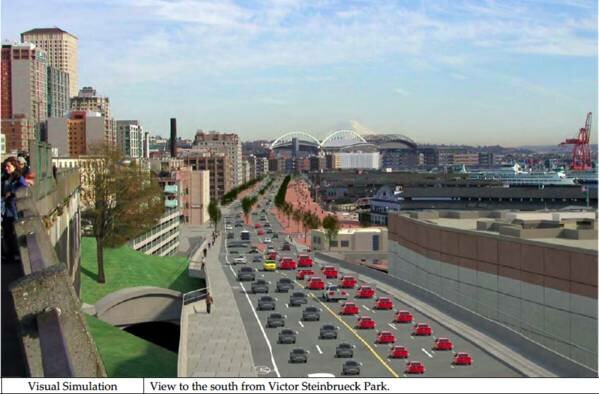 WDOT created a visualization of the waterfront boulevard that comes with the tunnel.
WDOT created a visualization of the waterfront boulevard that comes with the tunnel.
I've tried to help it reflect actual traffic.
Gering is quoting the high estimate for daily traffic on the Alaskan Way Viaduct currently, but he fails to mention that the tolled deep-bore tunnel is expected to handle only 47,000 daily vehicles. Some 35,000 cars are anticipated to take--that's right--city streets and I-5.
The difference between the Surface/Transit/I-5 alternative and the deep-bore tunnel is that dealing with surface street traffic is the primary goal of the former, while the tunnel plan does little to mitigate the traffic it sends to I-5 or city streets. There is $190 million recommended for transit as part of the tunnel plan, but it is unallocated, which is another way of saying that the tunnel plan contains 190 million wishes....
WikiLeaks' Twitter stream
Already someone with a lively sense of irony has visited Amazon's listing for the book The Pentagon Papers, writing:
Amazon pulled Wikileaks from their site because it represented classified government documents. So what is the Pentagon Papers still doing on this site? Oh right, Amazon wasn't around in 1971 to cave in to pressure from right wing politicians to betray the First Amendment right to publish classified materials that have been leaked by others.
TechFlash reports that Pentagon Papers-leaker Daniel Ellsberg himself is calling upon Amazonians to get into the transparency habit:
This would be a good time for Amazon insiders who know and perhaps can document the political pressures that were brought to bear—and the details of the hasty kowtowing by their bosses—to leak that information.
At issue is Amazon's claim that because WikiLeaks violated their terms of service hosting agreement by posting material they didn't own, Amazon was forced to terminate their hosting services--that is, it wasn't in response to governmental suasion. The Stranger's Paul Constant isn't buying it: "They need to issue a brief, clear statement on their information policies so consumers know where they stand with Amazon. If they're not going to fight for their customers' rights, their customers need to know that."
Amazon's hosting of the material aside, Salon's Glenn Greenwald can't understand why Tableau, a Seattle interactive graphics software company, also agreed to pull WikiLeaks charts in response to a request by Senator Joe Lieberman, chair of the Senate Homeland Security Committee. "These charts contained no classified information whatsoever, and disclosed nothing about the content of the cables," writes Greenwald. (See an example here.)
Tunnel enthusiasts and anti-enthusiasts: Stay focused! There's a lot of arguing yet to be done.
 Nick Licata, in one of his many hats
Nick Licata, in one of his many hats
The Stranger's news editor Dominic Holden "moderates" a skeptically-stacked panel that includes Mayor Mike McGinn, Councilmember Mike O'Brien, and Drew Paxton (Move Seattle Smarter). No official or unofficial representatives of the tunnel are on the panel because they refused the invitation to speak. WSDOT declined, stunningly, because they are in a public comment period.
Licata highlights two challenges to the deep bore tunnel. Move Seattle Smarter is busy working up an initiative that would rule out Seattle taxpayers ending up on the hook for potential cost overruns. And Tim Eyman, as I've previously mentioned, believes that I-1053 requires that tolling to pay tunnel construction would require a legislative vote. Notes Licata:
It may not be easy for the legislature to set tolls without opening up the issue of project funding and cost overruns. Worse, if the costs for the tunnel go over the set-aside contingency (i.e. goes over budget) the state legislature would need a two-thirds vote if they were to raise taxes to pay for the gap....
(more)
When I arrived this afternoon to interview Remy Trupin, executive director of the Washington State Budget & Policy Center, about the nuts-and-bolts of state budget allocation, he was still shellshocked from this morning's state revenue forecast.
The short story is that the projected deficit for the 2009-2011 and 2011-13 budget cycles has grown by $1.2 billion, to $5.7 billion, since September's forecast. The Hopper (the Senate Democrats blog) live-blogged the announcement, and that's where the following quotes come from:
Revenue for the remainder of the current budget cycle is projected to fall by $385 million to $28 billion. Revenue for the next cycle is projected to fall by $809 million to $33 billion.
"I would conclude that our forecast in September was more optimistic than it needed to be," said state chief economist Arun Raha, a qualification that should be immediately registered in a collection of classic understatements. Almost $300 million of the shortfall comes from the passage of I-1107, which rolled back taxes on bottled water, soda, and candy.
To balance the budget for the current budget cycle with cuts, the budget would need to be reduced by almost eleven percent across the board. To meet this year's shortfall, said Marty Brown, director of the state's Office of Financial Management, "We're going to be talking about Basic Health soon, Disability Lifeline soon, levy equalization. School districts are going to get nailed." ...

On November 30, two federal unemployment programs are set to expire: Emergency Unemployment Compensation and Extended Benefits. HuffPo notes that while the House has a vote coming up on an extension, the Senate has nothing on its schedule, so it is likely that--across the country--hundreds of thousands will no longer get unemployment checks.
Here in Washington State, the Employment Security Department's Jeff Robinson told me that the high-end estimate is that some 50,000 to 55,000 workers will have exhausted their emergency, longterm benefits by the end of the month. (That's a cumulative number, counting since Congress implemented Emergency Unemployment Compensation in July 2008. "More than 25,000 already had exhausted their benefits as of Oct. 31," the ESD told legislative committees yesterday.)
There are tiers to unemployment payments these days, after the unemployed worker has exhausted the state's typical 13 to 26 weeks of unemployment insurance. Federal emergency extensions have created four tiers totaling 53 additional weeks of benefits. ESD has created an "Impending Storm Workgroup," to help deal with the thousands of people losing a weekly income and to explain to people counting on those "extra" weeks that things have changed: Anyone who files a new claim after November 27 will be limited to 46 weeks of benefits.
What has not changed is Washington's unemployment rate, which refuses to budge from nine percent (9.1 percent if you want to enjoy an imaginary granularity; a year ago, the rate was 9.2 percent). Perhaps because this month is my birthday, the Seattle Times put Sanjay Bhatt to the task of surveying the state's unemployment situation, and the result is grim--18 percent of state residents are "underemployed"--but more inclusive in context, and accurate, than the Times has been inclined to dish up previously. ...
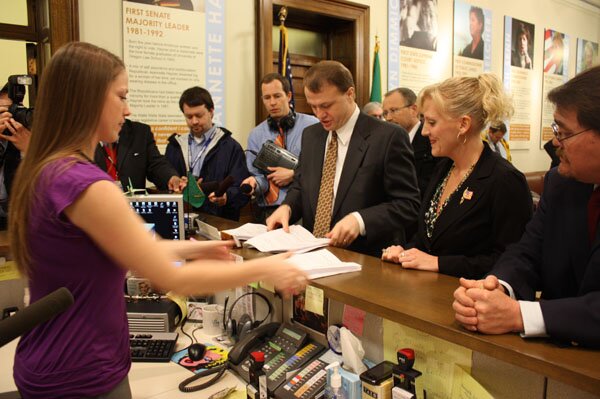 Tim Eyman filing I-1053 (Photo: Office of the Washington Secretary of State)
Tim Eyman filing I-1053 (Photo: Office of the Washington Secretary of State)
All our big road projects--the 520 bridge replacement, the deep-bore tunnel for SR 99--now routinely use tolls to fill in funding gaps. But yesterday, PublicCola reports, Tim Eyman was testifying in front of the Washington Transportation Commission that his I-1053 would require the legislature to drum up a supermajority to toll 520.
This would be news to WSDOT, who promise tolling will begin in spring 2011, with tolls ranging from $3.50 to $5 each way. Eyman also argued that the state can't even raise ferry fares (a planned 2.5 percent) without legislative approval.
I-1053 co-sponsor Sen. Pam Roach has asked Washington Attorney General Rob McKenna to weigh in on how broadly the initiative can be interpreted. While many people may have thought I-1053 applied mainly to taxes, it also said that "new or increased fees require majority legislative approval." Certainly the intent of the initiative backers was that it apply to precisely this sort of thing. That broad application was one of the reasons Sightline opposed the I-1053: Now even tax loopholes can't be closed without a supermajority.
If McKenna supports Eyman's view, it throws all the funding plans for our major transportation projects out the window. After all, tolling is supposed to pay for some $400 million of the Alaskan Way Viaduct Replacement project, a project that did not have supermajority support in the House....
Last week, the 100 to 150 inhabitants of the roving homeless camp Nickelsville were grumbling that the good news about a semi-permanent SoDo site, at the former Sunny Jim factory, was not great news, as there was still a winter to get through before the SoDo site would be ready for campers.
Today, Deputy Mayor Darryl Smith had an answer. For four to six months, Nickelsville can shelter at the site of the former Fire Station 39 (northwest corner of Northeast 127th Street and 30th Avenue Northeast) in Lake City.
"With snow forecast for this weekend and warnings of a long winter ahead, we moved fast to get the tent city residents into a secure and warm spot," Smith said. "During this time of economic hardship and limited resources, it is incumbent upon the city to make use of resources, such as the former fire station, with creativity and compassion. It is our hope that the temporary use by Nickelsville will be met with understanding."
Or not: "This is another example of the mayor just thrusting something on Lake City without consultation," Peter Lukevich, president of the Lake City Chamber of Commerce, told Seattlepi.com. Chuck Dickey, head of the Lake City Lions Club, seconded that motion: "We have enough homeless people in Lake City."
The city’s Department of Finance and Administrative Services, which owns and manages the old fire station and the new Fire Station 39 next door, will continue to manage the site. When and if approval is granted for the Sunny Jim relocation--that site still needs to be cleared and graded--a nonprofit or other organization will manage the encampment, providing services to residents and information for the city.
A few days ago, the Seattlepi.com's Joel Connelly was scolding Mayor McGinn for his "gratuitous personal insult directed at Gov. Chris Gregoire." At a press conference, McGinn said, "I don't believe we can trust the governor" to protect Seattle against cost overruns from the deep-bore tunnel project. The governor's spokesman Cory Curtis said that Gregoire simply doesn't believe overruns are a threat to Seattle.
That would be news to anyone who's spoken with the state legislature. The latest lawmaker to go on record vowing to make Seattle pay for any excess costs is Rep. Larry Seaquist, a Democrat from Gig Harbor. Seaquist told the Seattlepi.com, "I will be among those who make damn sure that deal stands in place. We bought our own bridge, you can buy your own tunnel" (a reference to funding of the second Tacoma Narrows Bridge).
Gov. Gregoire has mounted lawyerly arguments against the possibility of cost overruns, saying things that sound like there's little possibility of such a thing ever happening, and heaping scorn on McGinn as a foot-dragger. "What could cause a cost overrun? Delay," said the governor, despite the fact that, when it suits WSDOT, a year's extension to the project's timeline is spun as bringing costs down.
Gregoire has also called the specific provision "unenforceable," which may be technically true. But it's also disingenuous. The Legislature is perfectly capable of writing an enforceable provision, and Sen. Jim Kastama (another Democrat) went on record over a year ago to say, if costs exceed the budgeted amount, Seattle will pay. Note that these are both Democrats, and that recent Republican wins have cut into the Democratic majority in both House and Senate....
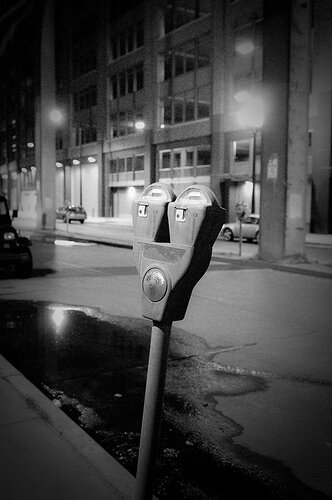 Photo courtesy Flickr pool superstar Slightlynorth
Photo courtesy Flickr pool superstar Slightlynorth
The City Council is going along with Mayor McGinn's plan to raise parking meter rates in Seattle, to as much as $4 an hour, but won't increase the parking tax rate paid by private lots and garages. They're also calling for two parking studies: one to determine the best rates for neighborhoods, and one to follow up on Tim Burgess's interest in dynamic parking pricing. (Here's his parking op-ed with Mike O'Brien.)
Nothing about the budget process is likely to be uncontroversial, but so far only PubliCola has paid much attention to the Council's tentative approval of City Attorney Pete Holmes' try at belt-tightening. Holmes wants the city to halt "a longstanding contract with private law firm Stafford Frey, which defends the police department in tort cases." He claims that many cases can be handled by city attorneys for about one-third the cost of Stafford Frey's billings, though the city will open more complicated cases for bid.
The savings could amount to $1 million. But as Dominic Holden reports in the Stranger, Rich O'Neill, president of the Seattle Police Officers' Guild, has threatened to sue the city if the union doesn't get the more pricy representation.
"Over the last six or seven years, this was a real hot potato," the Council's Nick Licata told Holden. It still is. But a $67 million deficit may have the last say.
Photo: Flickr pool member nate.gowdy
From arts and advocacy groups, to homeless encampments, the pressure is on to find a secure niche in the new economy. Earlier this week, Mayor McGinn wrote on his blog that the fire department was putting new restrictions on the use of Building 30 at Magnuson Park, reducing the number of events that can be held there to four from over 30.
A wide range of groups rent the hangar for larger public events--Friends of the Library Book Sale, the Arboretum Foundation Plant Sale, Best of the Northwest Craft Show--so the Mayor is suggesting that the city use $8.5 million in "MOHAI money" for a renovation of the space:
Parks estimates that, for $8.5 million, they can renovate building 30 to keep the hangar open for community events and can renovate the west wing for artist work space. This will bring in almost half a million dollars in annual revenue to Parks that they would not otherwise have. It will protect the $121,000 in event space rentals and will generate an additional $350,000 from work space rentals in the west wing.
The groups in question certainly agree. The vast majority of the post's 150 comments cheer the idea, which I think makes it the single most popular idea the Mayor has had since taking office. Now the public opinion screws will be turned on the City Council, who may find themselves forced to agree with the Mayor on something--or not.
The McGinn administration's other big idea, to find a "permanent" place for the city's roving homeless camps to stay, is not nearly as crowd-pleasing, but McGinn has at least left tonier Seattle neighborhoods relieved with his selection of SoDo's former Sunny Jim factory as a possible camp site. (Ballard is having trouble getting its mind around a homeless hygiene station because it will attract homeless people.)
Currently, the homeless of these tent cities face regular eviction, and it's one of the great shames of Seattle that the situation has continued for so long--the moral poverty of those who despise the homeless on a variety of grounds, or simply refuse to spend the time considering hard realities, far outdoing the physical poverty of the homeless....
 Graphic from Washington State Elections
Graphic from Washington State Elections
King County's estimated population is 1.9 million, of which almost 1.1 million are registered voters. Mid-term elections are historically less likely to draw people to the polls, but with all-mail voting, King County doesn't have to draw people anywhere but a mailbox. The result? A new record: 71 percent of King County's voters cast a ballot this year.
That might seem less impressive compared to the 84 percent turnout for the Presidential election in 2008, but it beats 2006's 65 percent, and 2002's 45 percent, handily. The rest of Washington state grumbles about King County "stealing" elections, but the county's impact is thanks to reality's well-known liberal bias: Only 3.6 million of Washington State's 6.6 million residents are registered voters, about 55 percent.
King County, the single most populous county, also has an edge in registered voters, at 58 percent. These marginal differences--in registered voters, in voter turnout--often make the difference. Senator Patty Murray's win this year is a case in point. Statewide, the Murray/Rossi race comes out to roughly 51 to 49 percent, but in King County it's currently breaking 63 to 36 percent, and King Country represents fully one-third of the state's registered voters. (In 2004, King County went for Murray over Nethercutt, 65 to 33 percent.)...
Dear Mr. Rossi:
Well, here we are yet again, with you on the losing side of another election. And yet again, you weren't able to muster enough votes outside of King County to overcome the usual overwhelming support for Democrats this county musters. Although you did do two percent better in King County than in 2008, you still couldn't crack the magic 40 percent mark a Republican needs in the county to have a chance at winning.
So, here you are yet again, out of a job. And this time around, you can't go back to real estate. I mean, have you seen the commercial real estate vacancy rate in Seattle? Over 17 percent. You ain't gonna make much money selling or leasing property in this economy. And don't even think about selling residential. You do read Seattle Bubble, right?
And I know you're thinking, Hey, I can latch on as a "political consultant." Let me remind you--you've now lost three times. And even if you want to say hey, I did win in '04, you got your rear spanked in 2008 by Christine Gregoire, a governor so ineffectual she makes Bartleby look like David Allen. I mean, seriously, you came into that election with the momentum and you lost by seven percent? You've done so poorly Alan Keyes could be your campaign manager and you'd do better.
Oh, hey, I can be a lobbyist down in Olympia, you think. And do what exactly? Get some tax breaks for the BIAW when the state budget is about to get another $5-$6 billion blown out of it this next biennium?
Again, you want to win political office, right? And you need to get 40 percent in King County, right? How you going to do that as the land man for the BIAW or the NRA or whatever right-wing lobby firm comes along?
Now, now, put down that Dick's job application. I have a modest proposal for you. I know it sounds crazy, and I know it'll make every Reagan-loving bone in your body ache, but here me out. There is an opening for a well-paying job that I think you'd be perfect for.
President of the University of Washington....
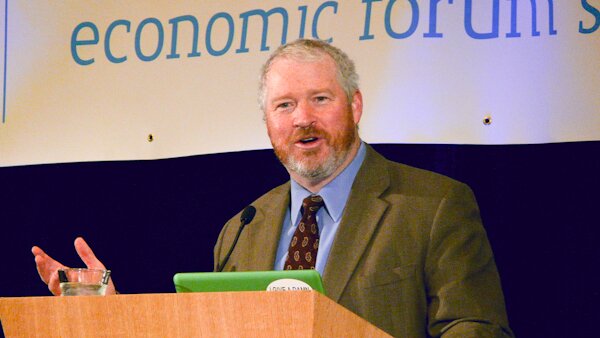 Mayor McGinn didn't get much runway from the Seattle Times.
Mayor McGinn didn't get much runway from the Seattle Times.
Ours are the politics of impatience. For Obama, it took less than seven months, amid all that chatter about health-care reform, and many people turned against him. This was not a case of people veering slightly away from his ideas; these were dramatic half-pirouettes. [...] What is it about us that we do not have a year or two to give a new president to make his mark?
It's a good piece but I think it would have been much stronger had Balter used her own tendency to rush to judgment as an object lesson, rather than note with near-Olympian detachment the behavior of others.
For instance, locally, Mayor McGinn was inaugurated on January 4, 2010. Here's Balter on December 30, just before McGinn took office:
McGinn comes in as a thousand question marks. He has sufficient public support to lead in a different direction. His election represents an anti-establishment theme in the city.
Yet aside from bicycles uber alles and more micro-process, I am not certain what his course will be.
McGinn, who was very accessible to the media during the campaign, employed an East German state media approach during the six weeks of transition. No one-on-one interviews unless he really likes you....
(more)
Hello!
Twitter: @thesunbreak | Facebook
iPhone app download (Free!)
Subscribe to The SunBreak
Delivery Options
![]() Subscribe to all SunBreak Stories
Subscribe to all SunBreak Stories
Daily Email Digest of The SunBreak
Most Viewed Stories
Recently in Our Flickr Photo Pool
www.flickr.com
|
Our Facebook Fan Page
Neighborhood Blog News
Niche Blog News
Seattle Weather
Get the SunBreak iPhone App

Download the SunBreak iPhone app for free.
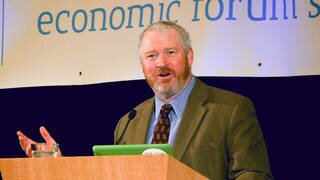
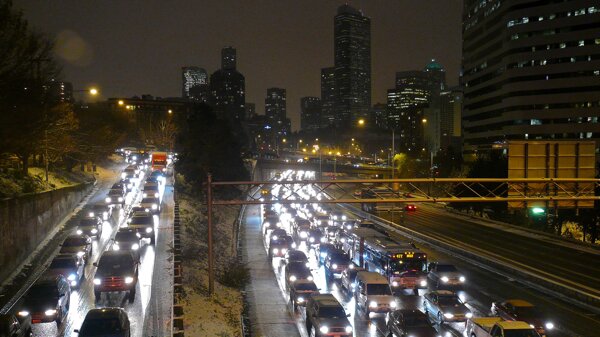





Most Recent Comments